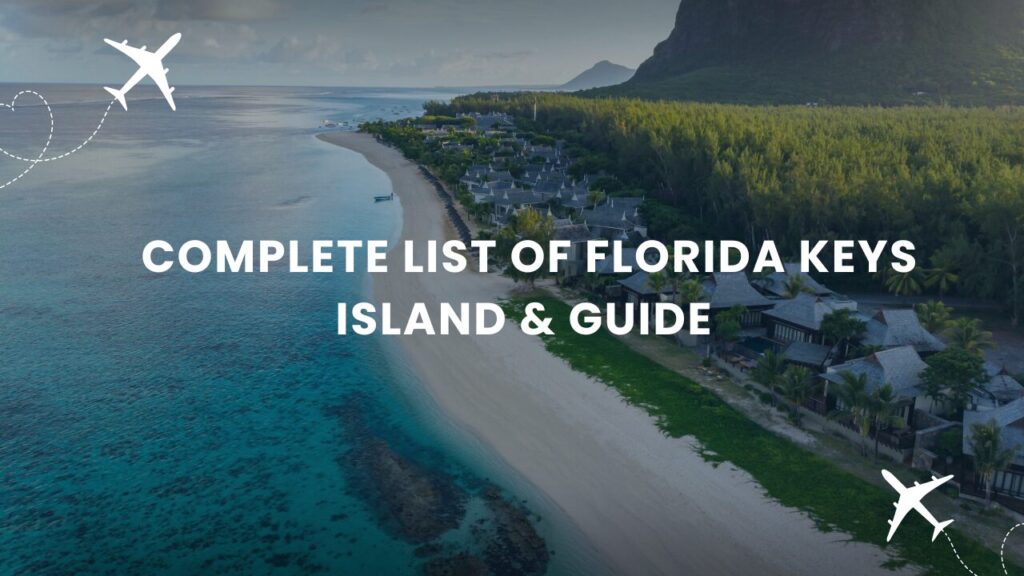The List of Florida Keys represents one of the most unique and breathtaking chains of islands in the United States. Stretching more than 120 miles from the southern tip of Florida’s mainland into the turquoise waters of the Gulf of Mexico and the Atlantic Ocean, the Keys are a natural wonder as well as a cultural treasure. Travelers are drawn to this subtropical paradise for its year-round sunshine, relaxed island atmosphere, coral reefs, historical sites, and the feeling of stepping into a completely different world without ever leaving the United States. The Florida Keys are more than just a vacation spot; they are a living, thriving ecosystem filled with stories of pirates, shipwrecks, artists, and adventurers, all wrapped in the beauty of the sea.
Geography and Layout of the Keys
The chain of islands is made up of more than 1,700 islands, although only about 40 are connected by the famous Overseas Highway, a feat of engineering that links the mainland to Key West at the far southern end. These islands are divided into four main groups: the Upper Keys, the Middle Keys, the Lower Keys, and Key West. Each section offers its own character and appeal, creating an evolving experience as you travel from north to south. This gradual transformation from the diving hubs of Key Largo to the cultural charm of Key West makes exploring the Keys an adventure that feels like moving through different chapters of a story.
Upper Florida Keys
Key Largo Gateway to the Keys
As the first stop on the island chain, Key Largo is often referred to as the “Diving Capital of the World.” Its proximity to the Florida Reef, the only living coral barrier reef in North America, makes it a haven for scuba divers and snorkelers. John Pennekamp Coral Reef State Park, established in 1963, was the first underwater park in the United States and continues to attract visitors eager to experience the colorful reefs, tropical fish, and even the Christ of the Abyss underwater statue. Beyond diving, Key Largo offers a relaxed environment filled with mangroves, nature trails, and waterfront dining, setting the tone for the rest of the journey.
Islamorada Sportfishing Paradise
Just south of Key Largo lies Islamorada, a collection of islands celebrated as the “Sportfishing Capital of the World.” Anglers from across the globe come here to test their skills in both shallow waters and deep-sea excursions. The island’s culture is heavily tied to the sea, and local charter captains have built a reputation for expertise in fishing waters that teem with marlin, tarpon, and sailfish. Beyond fishing, Islamorada offers luxury resorts, art galleries, and small-town charm. Visitors often find themselves staying longer than expected, caught between adventure on the water and relaxation onshore.
Middle Florida Keys
Marathon Family-Friendly Island Living
Continuing into the Middle Keys, travelers arrive at Marathon, a city that perfectly balances family-friendly activities with natural attractions. Marathon’s sandy Sombrero Beach is a favorite spot for swimming, snorkeling, and sunbathing, offering calm waters that make it especially appealing to families with children. Beyond its shoreline, Marathon is well known for the Dolphin Research Center, where visitors can interact with dolphins in a responsible and educational setting, and the Turtle Hospital, which has become one of the most respected facilities in the United States for rehabilitating injured sea turtles. Both of these institutions highlight the area’s dedication to marine conservation and create meaningful experiences for travelers who want their visit to make a positive impact.
Seven Mile Bridge An Icon of the Keys
One of the most remarkable features in the Middle Keys is the Seven Mile Bridge. Often considered a highlight of any trip through the islands, this engineering marvel stretches across open water, offering panoramic views of the Atlantic Ocean and the Gulf of Mexico. Driving across the bridge feels like gliding above turquoise waters, with endless sky above and sea below. It stands not only as a roadway but also as a symbol of connection, linking the islands and creating the unique accessibility that makes exploring the Florida Keys possible.
Lower Florida Keys
Big Pine Key and the Key Deer Refuge
The Lower Keys are less developed and provide a quieter, more natural escape compared to the busier Upper and Middle Keys. Big Pine Key is the heart of this region and is best known for being home to the endangered Key deer. These miniature deer, unique to the area, roam freely through neighborhoods and protected lands, enchanting visitors with their gentle presence. The National Key Deer Refuge was established to preserve this rare species and the habitats that support them, creating opportunities for eco-tourism and wildlife photography.
Natural Beauty and Outdoor Adventures
The Lower Keys also offer countless opportunities for outdoor adventures, from kayaking through mangroves to snorkeling in Looe Key Reef. Unlike the more populated areas, the waters here feel untouched, giving travelers a chance to experience the Keys in their most natural state. It is here that visitors find some of the most serene sunsets, secluded beaches, and quiet fishing spots. For those seeking peace and immersion in nature, the Lower Keys are often considered the hidden gem of the island chain.
Key West The Cultural Heart of the Keys
Key West marks the southernmost point of the continental United States and is the final destination for travelers exploring the island chain. This city blends history, culture, and vibrant energy, making it a must-see location. Ernest Hemingway once lived here, and his former residence remains one of the most popular attractions, filled with stories of the author’s life and the famous six-toed cats that still roam the grounds. The island’s historic Old Town is a patchwork of colorful wooden homes, art galleries, and charming shops.
Duval Street is the heart of the action, lined with restaurants, bars, and entertainment venues that keep the island buzzing both day and night. Key West is also known for its inclusive and welcoming community, attracting artists, musicians, and free-spirited travelers. Every evening, crowds gather at Mallory Square for the Sunset Celebration, where street performers, food vendors, and live music create a festival-like atmosphere to honor the day’s end.
The Unique Charm of the Florida Keys
The appeal of the Keys goes beyond their beaches and nightlife. What makes them truly unique is the blending of natural beauty with cultural richness. The islands offer access to North America’s only living coral reef, making them a diver’s paradise, while also preserving a laid-back Caribbean-style culture that feels worlds away from mainland Florida. The weather remains pleasant year-round, ensuring that no matter when visitors arrive, they can enjoy warm waters and sunny skies.
The Keys are also deeply tied to history, from tales of pirates and shipwrecks to their strategic role during the Cold War. Museums, historic forts, and lighthouses tell the stories of those who came before, ensuring that each island is not just a destination but also a part of America’s historical tapestry.
Conclusion
The List of Florida Keys is more than just a geographical outline; it is an invitation to explore an extraordinary stretch of islands filled with natural wonders, cultural treasures, and unforgettable experiences. From the coral reefs of Key Largo to the lively streets of Key West, the journey through the Keys is a passage through diverse worlds connected by the sea. Whether seeking adventure, relaxation, or history, the Florida Keys offer something for everyone, making them one of the most captivating destinations in the United States.
FAQs
What is the best time to visit the Florida Keys?
The best time to visit the Keys is between November and April, when the weather is comfortably warm and dry. This period avoids the heavy summer heat and the hurricane season that typically peaks from August to October.
How long does it take to drive through the Keys?
Driving from Miami to Key West along the Overseas Highway takes about four hours without stops, but most travelers take longer to explore the islands along the way. The journey itself is considered part of the adventure.
Are the Florida Keys family-friendly?
Yes, the Keys are very family-friendly, with attractions like the Turtle Hospital, Dolphin Research Center, and safe, sandy beaches in places like Marathon. Families often enjoy the relaxed pace and the many outdoor activities available.
Can you visit all the islands on the List of Florida Keys?
Not every island is accessible, as many are uninhabited or private. However, the main islands connected by the Overseas Highway around 40 in total offer plenty of opportunities for exploration.
What makes Key West different from the other Keys?
Key West stands out for its cultural vibrancy, nightlife, and history. While other Keys focus more on nature and relaxation, Key West offers a lively blend of entertainment, historic landmarks, and a diverse community spirit.





